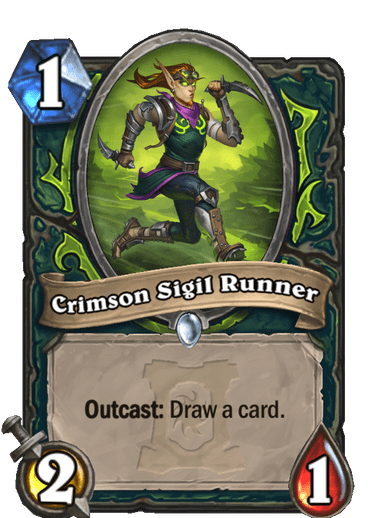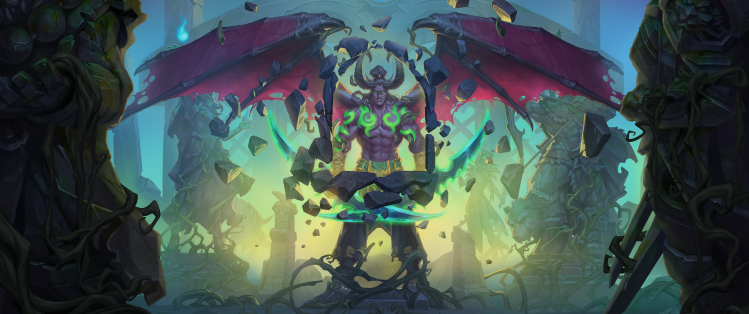Hearthstone‘s latest expansion, Ashes of Outland, released this week for PC and mobile. With it comes one of the most exciting additions to Blizzard Entertainment’s digital card game since it launched back in 2014: a new class.
Demon hunters enter the Hearthstone fray as an aggressive class with a focus on drawing cards and attacking with your hero. It’s a class that has a long history in Warcraft lore, with the night elf Illidan (turned part-demon through a dark ritual) showing up as the first demon hunter in 2002. Demon hunters then became a playable class in World of Warcraft with the Legion expansion in 2016.
I interviewed Hearthstone game director Ben Lee before the launch of the set about the challenges of adding a new class to the game, and why the team went with the demon hunter. And if you want to learn even more about the new class, check out our other recent Hearthstone interview.
Picking demon hunter
GamesBeat: There are three World of Warcraft classes that aren’t playable in Hearthstone: death knights, monks, and demon hunters. Why did demon hunter rise to the top?
Ben Lee: The team had already done their take on death knights in the Frozen Throne expansion. That ship sailed a little bit at least, for a significant amount of time. When thinking about what set we wanted to do, we wanted to do something we thought would be really big, really impactful. Outland and Burning Crusade are some of the most beloved time periods of the Warcraft license. Outland was something we were keen and happy to pursue. The natural fit for that would be demon hunter and Illidan as a character. Illidan is the title villain of the Burning Crusade expansion. It seemed like the perfect fit. Obviously demon hunters themselves, it’s a super-cool, really interesting class. For many players it’s their favorite class, even going back to the Warcraft III heroes in the campaign game there. Of the different choices we had, it seemed like right one at the right time.
GamesBeat: Are you telling me that monks will happen before death knights next?
Lee: Well, who knows?
GamesBeat: Did you want to give Illidan some redemption in Hearthstone? He’s been a legendary card since the beginning, but not a super-powerful one. Was it nice to make him more prominent?
Lee: Yeah, for sure. For me, I love the Warcraft license. It’s been hugely influential in my life and in my career. Doing proper justice to these big characters is important to me and to the team. We’re happy with how the demon hunter and Illidan have turned out. Very shortly players are going to be able to play it, and hopefully they’ll enjoy it.
GamesBeat: I know it can be challenging to establish an identity for each of the classes you already had. Was it hard to come up with a whole new class identity for a new class?
Lee: Yes and no. Class identity is important, but a lot of that comes through in terms of theming in art and effects and sound. There are some classes that have very specific mechanics, like Outcast is a demon hunter only mechanic. We can give them something that plays up their agility, their movement-based play style in the other games. It’s a mixture of different things. When you think about paladins, as an example, a lot of their flavor comes through in their artwork. There’s a lot of the holy light kinds of effects and colors, the yellows within their expansion sets.
It’s a big mixture of different factors. We’re happy with how it turned out with demon hunter. They have a few different varied playstyles that we think will emerge throughout the year. It’s probably going to trend more toward the fast play styles at the beginning, in the first expansion, but throughout the year we expect them to develop some token synergies, some big demon synergies. We’re happy with it. It also gives us a clean slate. If you look back at Hearthstone, it’s been six years since launch. A lot has changed. Our current team’s vision of class identities, compared to the original game, can be a bit different in some places. It’s hard to retroactively fix all these different things. With a new class it’s been exciting and interesting and fun for the team to be able to do that.
New hero, new tools
GamesBeat: The Outcast keyword, where it depends on whether the card is on the left or right in your hand, was that something you created when you wanted to do demon hunters, or is it a mechanic you were working with before you settled on bringing demon hunters to the game?
Lee: During the early phase of the expansion, the team was playing with a number of different mechanics and ideas. This was something they were thinking about — I think originally it was just a general mechanic we were trying. Then the team felt that it was very thematic for demon hunter. It felt like a good fit, and we kept it limited to them. For me personally, sometimes having a very unique mechanic for a class is interesting. If you look at rogue, the combo mechanic feels like something rogues would do. Secrets feel quite thematic for hunter and mage specifically. We’re happy we settled on it. It felt just like the right thing for Illidan and for demon hunter.

Above: Crimson Sigil Runner.
GamesBeat: How hard was it to develop the new hero power? Were there a lot of iterations before you settled on the one we have?
Lee: There were. The hero power might be the most challenging we did. For people that are reading this, it might seem really simple. It’s just 1 mana, 1 attack. Hero powers are really nuanced, though. They impact the game a huge amount. We don’t want them to impact the game too much, but we want them to impact the game enough. We’re a card game. We want you to be playing cards, not just using the hero power. We tried various different things. One idea we tried was it made your attacks avoid taunt, which sounds absolutely broken, but in practice it turned out to not be that useful. It depends on who you’re playing against, but often your enemy’s minions don’t even have taunt. It’s just a negligible bonus. In situations where you could use it, it just felt bad to be able to do that all the time on demand. It’s kind of a feast or famine idea. That’s not where we want hero powers to lie. We want it to be a consistent extra value if you have the excess mana to be able to do it.
We wanted to do something with attacking, though. That was consistent from the start. We wanted the demon hunter to pick up off the board, attack enemy minions or attack the enemy hero. If you’ve seen Illidan in Heroes of the Storm or Warcraft III or even World of Warcraft, he’s super agile, jumping around. Demon hunters have huge movement-based kit in their games. We wanted to fulfill that fantasy for demon hunter. Attacking was our allegory for that. The 1 mana idea is something that came pretty late in, but it felt right. It’s something you can do often. You can always get into the thick of the action as a demon hunter. At the beginning of the battle you can jump forward and attack before anyone else gets a chance. It felt right, and we’re super happy with it.

